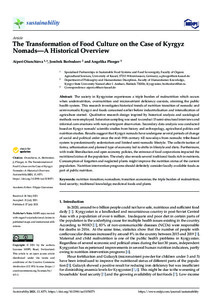| dc.date.accessioned | 2021-10-18T10:20:39Z | |
| dc.date.available | 2021-10-18T10:20:39Z | |
| dc.date.issued | 2021-07-27 | |
| dc.identifier | doi:10.17170/kobra-202110084865 | |
| dc.identifier.uri | http://hdl.handle.net/123456789/13297 | |
| dc.description.sponsorship | Gefördert durch den Publikationsfonds der Universität Kassel | ger |
| dc.language.iso | eng | eng |
| dc.rights | Namensnennung 4.0 International | * |
| dc.rights.uri | http://creativecommons.org/licenses/by/4.0/ | * |
| dc.subject | nutrition transition | eng |
| dc.subject | nomadism | eng |
| dc.subject | transition economies | eng |
| dc.subject | the triple burden of malnutrition | eng |
| dc.subject | food security | eng |
| dc.subject | traditional knowledge | eng |
| dc.subject | medicinal foods and plants | eng |
| dc.subject.ddc | 300 | |
| dc.title | The Transformation of Food Culture on the Case of Kyrgyz Nomads - A Historical Overview | eng |
| dc.type | Aufsatz | |
| dcterms.abstract | The society in Kyrgyzstan experiences a triple burden of malnutrition which occurs when undernutrition, overnutrition and micronutrient deficiency coexists, straining the public health system. This research investigates historical trends of nutrition transition of nomadic and semi-nomadic Kyrgyz and foods consumed earlier before industrialisation and intensification of agriculture started. Qualitative research design inspired by historical analysis and sociological methods were employed. Saturation sampling was used to conduct 15 semi-structural interviews and informal conversations with non-participant observation. Secondary data analysis was conducted based on Kyrgyz nomads’ scientific studies from history and anthropology, agricultural politics and nutrition studies. Results suggest that Kyrgyz nomads have undergone several periods of change of social and political order since the mid-19th century till nowadays from nomadic tribe-based system to predominantly sedentarism and limited semi-nomadic lifestyle. The collectivisation of farms, urbanisation and planned type of economy led to shifts in lifestyle and diets. Furthermore, with trade liberalisation and open economy policies, the entrance of food corporations impacted the nutritional status of the population. The study also reveals several traditional foods rich in nutrients. Consumption of forgotten and neglected plants might improve the nutrition status of the current population. Nutrition intervention programs should definitely consider locally available foods as part of public nutrition | eng |
| dcterms.accessRights | open access | |
| dcterms.creator | Otunchieva, Aiperi | |
| dcterms.creator | Borbodoev, Jorobek | |
| dcterms.creator | Ploeger, Angelika | |
| dc.relation.doi | doi:10.3390/su13158371 | |
| dc.subject.swd | Kirgisien | ger |
| dc.subject.swd | Ernährung | ger |
| dc.subject.swd | Umstellung | ger |
| dc.subject.swd | Nomade | ger |
| dc.subject.swd | Übergangsgesellschaft | ger |
| dc.subject.swd | Wirtschaft | ger |
| dc.subject.swd | Unterernährung | ger |
| dc.subject.swd | Überernährung | ger |
| dc.subject.swd | Mikronährstoff | ger |
| dc.subject.swd | Ernährungssicherung | ger |
| dc.type.version | publishedVersion | |
| dcterms.source.identifier | eissn:2071-1050 | |
| dcterms.source.issue | Issue 15 | |
| dcterms.source.journal | Sustainability | eng |
| dcterms.source.volume | Volume 13 | |
| kup.iskup | false | |
| dcterms.source.articlenumber | 8371 | |


